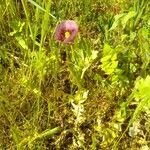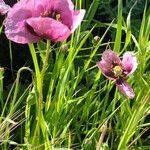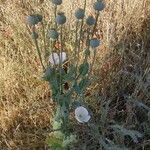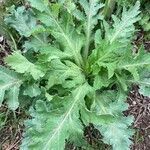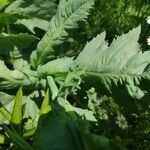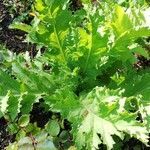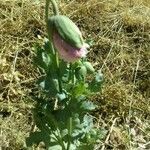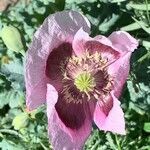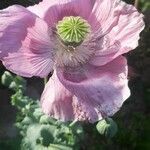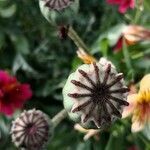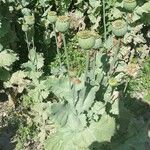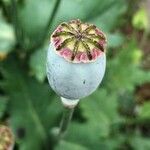Annual herb; rosette tufted; stems erect, glabrous, 30-60-(150) cm tall. Lvs glaucous, (2)-4-8-(15) × (0.5)-5-12-(15) cm, the lower cuneate at base and shortly petiolate, the upper sessile and amplexicaul. Lamina ovate-oblong, shallowly pinnatifid and irregularly and coarsely lobed or toothed, glabrous or with a few stiff hairs on midrib and margins. Pedicels to 30 cm long, glabrous or with sparse bristly or soft hairs. Sepals glabrous or hairy, (5)-15-30-(40) × (4)-10-20-(30) mm. Petals usually pink or mauve, rarely white or red, 2-7 × 2-7 cm, usually with large dark blotch near base. Capsule broadly ovoid or obovoid to globose, widest at or above 1/2 way, shortly stipitate, not ribbed, glabrous, (10)-15-40 × (5)-10-40 mm. Stigmatic disc slightly wider than capsule, flat or concave; rays (5)-7-11-(15).
Plant annual, caulescent, to 1.5 m high, almost glabrous to setose, without prickles, glaucous. Stems simple or branching. Leaves to 30 cm long; upper leaves stem-clasping; lamina unlobed or pinnately lobed, usually shallowly to deeply toothed; lobes not prickle-tipped. Peduncle often sparsely setose. Sepals glabrous or setose. Petals to 60 mm long, white, pink, red or purple, often with dark or pale basal spot. Stamens: filaments white to dark violet, filiform or clavate; anthers pale yellow to brownish. Ovary glabrous; stigmas 5–18; disc ± flat. Capsule stipitate, subglobose, to 9 cm long, not ribbed, glabrous, glaucous.
Plants to 15 dm, glabrate, glaucous. Stems simple or branching. Leaves to 30 cm; blade sometimes sparsely setose abaxially on midrib; margins usually shallowly to deeply toothed. Inflorescences: peduncle often sparsely setose. Flowers: petals white, pink, red, or purple, often with dark or pale basal spot, to 6 cm; anthers pale yellow; stigmas 5-18, disc ± flat. Capsules stipitate, subglobose, not ribbed, to 9 cm, glaucous.
Stout annual to 1 m, glaucous and mainly glabrous except for the distally hispid peduncles; lvs sessile, coarsely toothed or shallowly lobed, with cordate-clasping base; buds 2–4 cm; pet 3–6 cm, purple or red to white; fr glabrous, 2.5–6+ cm, subglobose or broadly obovoid; stigmatic rays 8–15; 2n=22. Native of the Mediterranean region, modified in cult., often escaped in our range. June–Sept.
An annual plant which grows up to 60-150 cm high. It is 20 cm across. The leaves are coarsely toothed and clasp the stem. They are smooth and undivided. They are wavy. They are blue-green. The flowers are showy. They are cup shaped and red, white or purple. They are on long erect flower stalks. The fruit is a seed pod. It yields a milky sap. The capsule is 2-5 cm wide.
